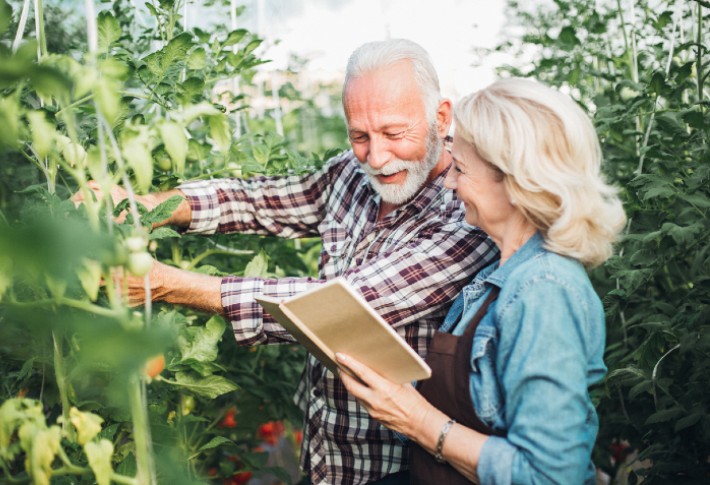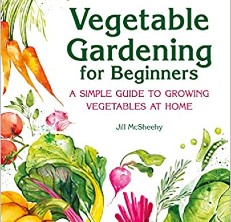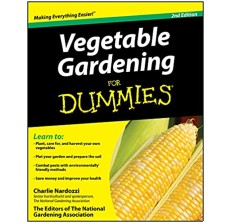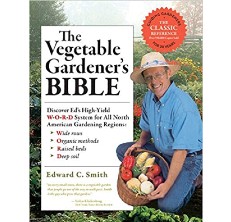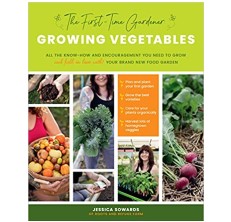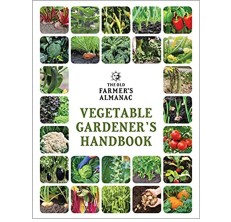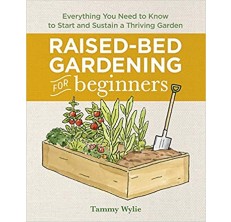- Flowers & PlantsVegetables
The Best Vegetable Garden Books of 2024
Last updated: Apr 17, 2024
.
Creating your own garden from scratch without any previous experience can be intimidating. But the best thing about starting any new hobby is that millions of people have done it before you, and plenty of resources are available to guide you along the way. Books on gardening are invaluable to beginners, as they can help you avoid common pitfalls like overwatering, plant crowding, and using the wrong soil types. We’ve researched the best vegetable gardening books to help you choose what kind of garden you want to create. The best overall book on the list is Vegetable Gardening for Beginners by Jill McSheehy because of its informative diagrams, easy-to-understand definitions and explanations, and useful tips for beginners.
Our Top Picks For Vegetable Gardening Books
- Best Overall: Vegetable Gardening for Beginners Shop Now ➔
- Best for Beginners: Vegetable Gardening for Dummies Shop Now ➔
- Most Informative: The Vegetable Gardener's Bible Shop Now ➔
- Most Accessible: The First-Time Gardener: Growing Vegetables Shop Now ➔
- Best Visual Aids: The Old Farmer's Almanac Vegetable Gardener’s Handbook Shop Now ➔
- Best for Raised Bed Gardens: Raised Bed Gardening for Beginners Shop Now ➔
- Great for Vertical Gardens: Vertical Gardening: Grow Up, Not Out, for More Vegetables and Flowers in Much Less Space Shop Now ➔
View all ContentsThe Best Vegetable Garden Books
Best Overall
If you’re a beginner and want to grow a vegetable garden at home, then this book will help you nurture the garden of your dreams. This book by Jill Mcsheehy, host of The Beginner’s Garden podcast, was published in April 2020. This book details how to start from scratch – preparing starter pots, constructing plant beds, and mixing soil. Building off of initial concepts, the book helps you choose suitable plants with the help of in-depth profiles on plants, from peppery arugula to fragrant rosemary and cool melons. When it comes time to harvest, the book also provides all the steps to nourish plants to their harvest.
Pros
- Very easy guide for beginners
- Builds the ideal foundation for a vegetable garden
- Helps you pick the right plant for your set up
- A simple guide for starting seeds indoors and harvest with joy
Cons
- Some users might find a lack of information about some steps
- Doesn’t include enough images for guidance
Best for Beginners
Charlie Nardozzi is a recognized gardener, speaker, and television personality with more than 20 years of experience. His book is a complete guide for beginners in home vegetable gardening. This practical guidebook teaches you to nurture ripe vegetables and even offers humor along the way. With this book, you will learn about the best suitable soil mixtures for a perfect home garden with expert advice on farming and harvesting. In this guide, you will also learn to protect plant viability by controlling pests and insects that threaten vegetable growth.
Pros
- Practical guide book from an experienced writer
- Step by step guidelines to grow your farm
- New updates about watering plants and new harvesting methods
Cons
- Skips over some beginner steps
- Some readers might find it lengthy with over 350 pages
Most Informative
Edward C. Smith has more than 30 years of experience in the field of gardening. His first book, The Vegetable Gardener’s Bible, was published in December 2009. This book covers all sorts of setup problems and guidance which a beginner needs. Due to higher-level professional terms and methods, some novices may be confused while reading. This book contains step-by-step methods that are involved in farming a home garden. It will help you choose a good soil type and let you select the best plants for your garden. The Vegetable Gardener’s Bible covers a lot of reliable gardening techniques. It also focuses on the end stages of harvesting.
Pros
- Professional step-by-step guidance with natural farming techniques
- Best suited for those who already have beginner knowledge
Cons
- Some techniques might be considered expert-level
- Some beginners might be confused or overwhelmed
Most Accessible
You are excited to farm your vegetables but don’t know where to start, then this book is a total guide for you to set up your home vegetable garden. Published recently in March 2021, this book has answers to the questions that a beginner might ask. From scouting garden locations to mixing suitable soil and different types of vegetables to watering methods, all the guidance you need is available in this 186 pages book. This book also features some eco-friendly and reliable gardening methods. It’s an ideal guide for beginners, so experts might not want to invest.
Pros
- Concise information with beautiful pictures
- Easy-to-understand guide for beginners
- Provides basic concepts about starting a vegetable garden
Cons
- Primarily focuses on soil suitability with less content on planting methods
- Good for a beginner, but not helpful for those with an established garden
Best Visual Aids
The Old Farmer’s Almanac Vegetable Gardener’s Handbook is a perfect companion for novices and experts alike! The handbook explains farming a garden by providing the best methods for seeding, growing, and harvesting. It provides ideas and techniques for planting various types of easy-to-grow vegetables. Colored photos also help for better understanding. The reference tables and charts are ideal for visual learners. In a nutshell, it’s a complete basic handbook and step-by-step guide from how to select soil to harvesting seeds.
Pros
- Step-by-step guide for more than 30 types of vegetables
- Easy-to-use techniques for plant growing
- More than 150 colored photos with helpful charts
Cons
- Very basic guidance with lack of professional methods
- Some users might find the book damaged during shipping
Best for Raised Bed Gardens
Are you concerned about having enough space to foster healthy plants? Raised Bed Gardening for Beginners by Tammy Wylie will show you how simple it can be to prepare, build, and grow a garden in whatever space is available. Learn to build a raised plant bed, select the right plants, and create herbal medicines from your grown vegetables. This book contains relatively basic information, so it is best suited for beginners only and not for those with established gardens.
Pros
- 30 common vegetables and herbs profiles
- Easy-to-follow language
Cons
- The author doesn’t elaborate too deep on topics, so again, it’s best for beginners
Great for Vertical Gardens
The most common mistake novice gardeners make is starting a garden that’s too big and realizing very soon that their plants require too much watering, weeding, and labor. Vertical gardening assurances a better outcome from the very first day when the trowel hits the soil and takes less space in the home. By following the guidelines in the book, vertical gardening can be carried out in small spaces, even if you just have a 12-inch space against the walls. Vertical gardens require less work while still producing a high output.
Pros
- 100 photos of different planting techniques
- Provides specific instructions on vertical gardening
Cons
- Only suitable for those who want small gardens
The Best Vegetable Gardening Book Buying Guide
As there are a lot of books available on the market, you might be confused about which book is the best option. We hope this guide helps you decide what is best for you.
What Are Features To Look for in Gardening Books?
The market is full of different kinds of gardening books for growing vegetables. To pick the best, you have to be clear about a few things. You will easily find books in-store and even online targeting different audiences. You might see books according to levels of knowledge like the ones below.
Beginner
It’s for an audience that’s new to the gardening scene. Beginner books cover all the basic concepts that a person should know before they step into the gardening world.
Intermediate
These books will be more advanced in comparison to the beginner’s book. For example, they might go into more depth about the science of gardening.
Expert
This category will have the most advanced books. It will provide you with the most detailed information without covering the basics first.
What Are Some Key Considerations for Picking the Best Vegetable Gardening Books?
Buying a good and informative vegetable gardening book needs some important consideration. Here are some important considerations when picking the right book.
Author’s biography
A book is as good as its author. So, it is important for you to be aware of any option’s author and their relevant experience. You can do research on the best authors for the vegetable gardening book and then make a list of the books you like.
After that, you should go through reviews or summaries to make your final decision. It is important for a reader to properly understand the content of the book. You can find different authors for a beginner’s book to get started and have basic knowledge about vegetable gardening.
Content of the book
There are thousands of books out there, yet each is unique. The best way to evaluate the content of a book is to check out headings in the table of contents or chapter titles.
Take a bird’s eye view of the table of contents to get an idea about the topics covered inside the book. If the content is in accordance with your needs, then go for it.
Price matters
If you are a beginner and planning to buy an expert-level vegetable gardening book, then this is not going to be beneficial. Do check the price and content of the book before you make a purchase. Spending extra money on information that you don’t need or don’t understand is not a good investment.
Secondly, it’s your choice to either pick a hard copy or get an e-book online. One of the key benefits of an e-book is that you can keep them on any of your electronic devices like mobile phones, laptops, tablets, and desktops.
What Is the Price Range of Vegetable Gardening Books?
As said above, the price of a book matters a lot! Note that vegetable gardening books come with different price tags. The price range can be split down into three categories:
Cheap
Amazon is full of many affordable books that you can buy to kick start your vegetable gardening project. You can get a book with a price tag between $2 to $10.
Mid-range
In this range, you can buy books ranging between $12 to $22.
Expensive
Get books with a price tag between $23 to $39. The authors of the books are experts in their field and offer an in-depth insight into the subject matter.
If you can’t wait to get your hands on your new vegetable gardening book, though, check out this video and Huw Richards’s 17 vegetable gardening hacks that you can implement today!
People Also Asked
How to pick the best vegetable gardening books in 2021?
To pick the best vegetable gardening books, you can conduct research and read reviews like this one. One of the best retail platforms for buying gardening books is Amazon.
What are the top gardening tips for beginners?
Gardening books can provide a lot of information. Most books for beginners emphasize these topics: selecting the proper location with adequate space and sunlight, mixing nutrient-rich soil, making a watering schedule, and adding other nutrients like plant food.
Article Contributors
Read More About Garden Gate Review Team HereThe Garden Gate Review Team’s product reviews and in-depth guides are here to help you choose the best products for a beautiful and bountiful garden and backyard. The content is created by The Garden Gate Review Team. Garden Gate’s editorial staff is not involved. Garden Gate is reader-supported: When you buy through links on our site, we may earn an affiliate commission. The Garden Gate Review Team is composed of authors, editors, and gardeners. Artificial Intelligence (large language models) may have been used in the research and creation of the content.
Please reach out to aimperiapt@gmail.com with any questions regarding product testing or specific articles.
